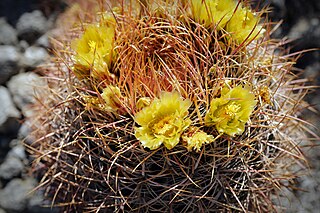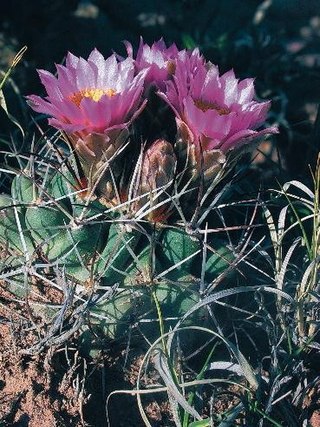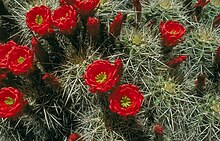
Fouquieria splendens is a plant indigenous to the Mojave Desert, Sonoran Desert, Chihuahuan Desert and Colorado Desert in the Southwestern United States, and northern Mexico.

Echinocereus is a genus of ribbed, usually small to medium-sized, cylindrical shaped cacti, comprising about 70 species native to the southern United States and Mexico in very sunny, rocky places. Usually the flowers are large and the fruit edible.

Echinocereus engelmannii, the strawberry hedgehog cactus or Engelmann's hedgehog cactus, is a cactus commonly found in desert areas of the southwestern United States and the adjacent areas of Mexico, including the states of California, Nevada, Utah, Arizona, Baja California and Sonora.

Echinocereus reichenbachii is a perennial plant and shrub in the cactus family. The species is native to the Chihuahuan Desert and parts of northern Mexico and the southern United States, where they grow at elevations up to 1,500 meters (4,900 ft). This cactus earned the Royal Horticultural Society's Award of Garden Merit.

Ferocactus cylindraceus is a species of barrel cactus which is known by several common names, including California barrel cactus, Desert barrel cactus, compass barrel cactus, and miner's compass. It was first described by George Engelmann in 1853.

Pelecyphora vivipara is a species of cactus known by several common names, including spinystar, viviparous foxtail cactus, pincushion cactus and ball cactus. It is native to North America, where certain varieties can be found from Mexico to Canada. Most of these varieties are limited to the Mojave and Sonoran Deserts. The species epithet "vivipara" is due to the species' viviparous reproductive habit.

Opuntia basilaris, the beavertail cactus or beavertail pricklypear, is a cactus species found in the southwest United States. It occurs mostly in the Mojave, Anza-Borrego, and Colorado Deserts, as well as in the Colorado Plateau and northwest Mexico. It is also found throughout the Grand Canyon and Colorado River region as well as into southern Utah and Nevada, and in the western Arizona regions along the Lower Colorado River Valley.

Echinocereus chisoensis is a rare North American species of cactus known by the common name Chisos Mountain hedgehog cactus, native to the Chihuahuan Desert of northern Mexico and the south-central United States.

Echinocereus fendleri is a species of cactus known by the common names pinkflower hedgehog cactus and Fendler's hedgehog cactus. It is named in honor of Augustus Fendler.

Echinocereus viridiflorus is a species of cactus known by the common names nylon hedgehog cactus, green pitaya, and small-flowered hedgehog cactus. It is native to the central and south-central United States and northern Mexico, where it can be found in varied habitat types, including desert scrub, woodlands, dry grasslands, and short-grass prairie.

Sclerocactus glaucus is a rare species of cactus known by the common name Colorado hookless cactus. It is endemic to Colorado in the United States, where it is known only from the area between Grand Junction and Montrose. It is a federally listed threatened species.

Echinocereus dasyacanthus is a member of the cactus family, Cactaceae. It is one of about 2000 total species belonging to this family. The cactus is commonly known as Texas rainbow cactus because of the subtle rings or bands of contrasting colors along the stem of the plant. Not all Texas rainbow cacti have the "rainbow" coloration on their stems. Another common name is spiny hedgehog cactus.

Sclerocactus sileri, the Siler fishhook cactus, is a rare and very small cactus found mostly in mineral-rich desert areas of intermediate elevations, notably in the American states of Utah, Nevada, and northern Arizona.

Echinocereus berlandieri is a species of hedgehog cactus. Its range includes most of South Texas, and is commonly found along the Nueces River and the lower Rio Grande.

Echinocereus arizonicus is a species of cactus native to the Chihuahuan Desert region of Chihuahua, southwestern New Mexico and southeastern Arizona, as well as in the Superstition and Mescal Mountains of Central Arizona. An endangered variable of the species "Echinocereus triglochidiatus arizonicus" is found exclusively in sections of the Superstition, Mescal, and Pinal Mountains. Genetic studies have indicated that this variable of the species does not occur outside these mountain ranges.

Echinocereus fasciculatus, commonly known as pinkflower hedgehog cactus, is a clumping cactus (Cactaceae) with brilliant magenta flowers and long spines found in the Sonoran Desert.

Echinocereus coccineus is a species of hedgehog cactus. Its native to Northern and Central America. It grows on full sun, in sandy or rocky well-drained soil. It can survive in hardiness zones 8–11.

Echinocereus rigidissimus, commonly known as the Arizona rainbow cactus or rainbow hedgehog cactus is a solitary growing cactus that rarely branches or offsets with age.

Echinocereus enneacanthus is a species of flowering plant first described by George Engelmann.

Echinocereus websterianus, commonly known as the San Pedro Nolasco hedgehog cactus or Webster's hedgehog cactus, is a species of cactus. It is named after American philanthropist Gertrude Webster, who cofounded the Desert Botanical Garden in Phoenix, Arizona.






















